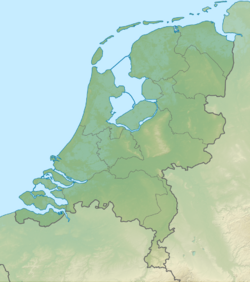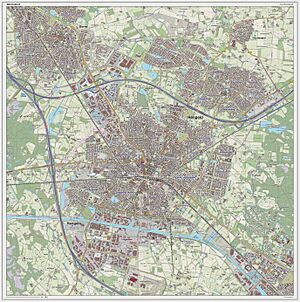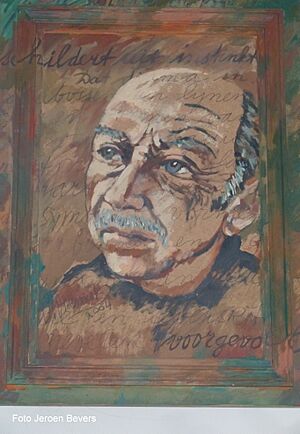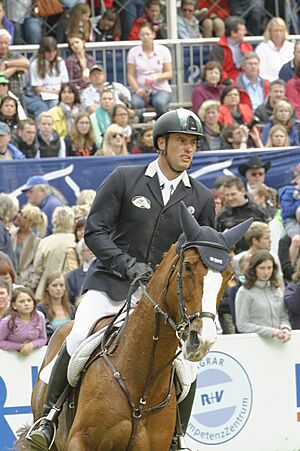Hengelo facts for kids
Quick facts for kids
Hengelo
Hengel (Twents)
|
|||
|---|---|---|---|
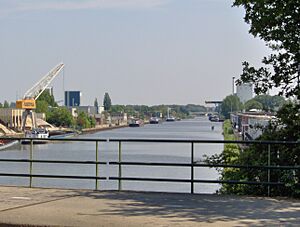
Twentekanaal through Hengelo
|
|||
|
|||
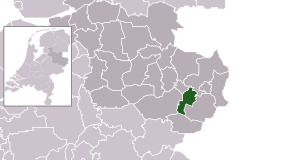
Location in Overijssel
|
|||
| Country | Netherlands | ||
| Province | Overijssel | ||
| Government | |||
| • Body | Municipal council | ||
| Area | |||
| • Total | 61.83 km2 (23.87 sq mi) | ||
| • Land | 60.90 km2 (23.51 sq mi) | ||
| • Water | 0.93 km2 (0.36 sq mi) | ||
| Elevation | 18 m (59 ft) | ||
| Population
(2023)
|
|||
| • Total | 82,311 | ||
| • Density | 1,331/km2 (3,450/sq mi) | ||
| Demonym(s) | Hengolian | ||
| Time zone | UTC+1 (CET) | ||
| • Summer (DST) | UTC+2 (CEST) | ||
| Postcode |
7550–7559
|
||
| Area code | 074 | ||
| Climate | Cfb | ||
Hengelo (Dutch: [ˈɦɛŋəloː]; Tweants: Hengel) is a city in the eastern part of the Netherlands. It is located in the Twente region, within the province of Overijssel. Hengelo is part of a larger group of cities, including Enschede, Borne, Almelo, and Oldenzaal.
Because of its low-lying landscape, many streams meet in Hengelo. This made it a natural meeting point and a place where people settled very early in history. Today, it is an important center for transport and industry. In the 1800s, factories needed a lot of water for cleaning textiles and for their steam engines. Over time, Hengelo became known as metaalstad, which means "metal city." This is because of its many factories that made machines and electrical equipment. Salt mining also became a big industry, leading to the creation of other chemical products.
Hengelo was bombed during World War II because of its important railways and factories. After the war, the city was rebuilt with a modern design. This new plan changed some of the older buildings. Famous Dutch planners and architects helped design new parts of the city. They created new neighborhoods inspired by the "garden city" idea, which mixes city life with green spaces. Many students and graduates from the University of Twente and ArtEZ University of Arts in Enschede now live and work in Hengelo. This has helped the city grow economically and culturally.
Contents
Exploring Hengelo's Communities
- Beckum
- Hengelo
- Oele
Hengelo's Past: A Journey Through Time
Archaeologists have found signs that people lived in Hengelo a very long time ago. They discovered a camp site for hunters and gatherers from the Mesolithic period, which was between 12,000 and 5,000 years ago. It seems people have lived here ever since. Tools and pottery from the Iron Age and Roman times have also been found.
In the mid-1200s, a large estate called Huys Hengelo was built. A village grew around it, with a church and a cemetery. This estate was involved in several battles during the Spanish occupation of the Netherlands. The municipality of Hengelo was officially formed in 1802. At that time, it was mostly farms and homes for agricultural workers.
Hengelo was never officially granted "city rights" like some older towns. It grew from a village into a city during the Industrial Revolution in the 1800s. During this time, important buildings were constructed. These include the Waterstaatskerk (built in 1839) and the Lambertusbasiliek (built in 1890). The Lambertusbasiliek is a large Roman Catholic church dedicated to Saint Lambert.
After the railway station was built in 1866, industry grew very quickly. Companies like Stork B.V., Hazemeyer, and Hollandse Signaal Apparaten (now part of the Thales Group) focused on technology. Stork was especially important for Hengelo. They built a "garden village" called Tuindorp 't Lansink in the 1910s to house their workers. Stork also helped build public places in the city center, like a library.
Hengelo was also home to a local brewery called Hengelo Bier. Today, a beer brand called Twents is made in Hengelo by De Twentse Bierbrouwerij. This brewery started in 2007.
During World War II, the city was bombed by the Allies. This happened because of the important railways and factories that were helping the occupying forces. On October 6 and 7, 1944, the center of Hengelo was accidentally destroyed, and many people lost their lives.
After World War II, several historic buildings were torn down. These included the synagogue, a block of buildings called De Telgen, a monastery, and the 19th-century town hall. This meant the city lost much of its old center. However, the plan to rebuild Hengelo, including its town hall (built 1958-1963), was highly praised. It is now seen as a key example of how Dutch cities were planned after the war. Hengelo also became known for its modern architecture, with new housing designs like Klein Driene I & II and De Kasbah.
Getting Around Hengelo
Hengelo is a major transport hub, meaning it's easy to get around using different types of transport.
By Car
- Hengelo is located along the A1 motorway. This road connects Amsterdam to the Dutch-German border. It is also part of the E30 route, which goes all the way from Cork, Ireland, to Omsk, Russia.
- The A35/N35 motorway starts near the German border. It leads to the south side of Enschede and then runs along Hengelo's western side.
By Train
- Hengelo Railway Station is part of the train service that runs between Amsterdam and Berlin. You can catch international trains daily to places like Bad Bentheim and Berlin.
- From Hengelo, you can also travel directly to many cities across the Netherlands. These include Almelo, Amsterdam, Enschede, Utrecht, and Zwolle. For more travel information, you can visit the station or the website of Dutch Railways.
- Besides the main station, Hengelo has two smaller train stations. Hengelo Oost serves a residential area and leisure spots. Hengelo Gezondheidspark provides access to the city's main health care complex, which includes a hospital.
By Bus
- Within Hengelo, you can travel by train and bus. These services are provided by Arriva. The city has special bus lanes to help buses travel faster.
By Bike
- Hengelo has a large network of cycle paths both inside and outside the city. Part of this is the Bicycle Highway F35 (Fietssnelweg F35). This path connects Hengelo with other towns like Nijverdal, Almelo, and Enschede.
By Boat
- The Twentekanaal (canal) links the Twente region to the IJssel river. This canal is mostly used for transporting goods. Hengelo has a large harbour with various industries located along it.
Hengelo's Weather
Hengelo has an oceanic climate, like most of the Netherlands. However, because it's inland, its winters are usually colder than areas near the coast. Summers are also warmer. The weather station for the Royal Netherlands Meteorological Institute is still located at the former military airport, even though the airport is no longer in use.
| Climate data for Twenthe (1981-2010) | |||||||||||||
|---|---|---|---|---|---|---|---|---|---|---|---|---|---|
| Month | Jan | Feb | Mar | Apr | May | Jun | Jul | Aug | Sep | Oct | Nov | Dec | Year |
| Mean daily maximum °C (°F) | 4.8 (40.6) |
5.7 (42.3) |
9.5 (49.1) |
13.9 (57.0) |
18.0 (64.4) |
20.5 (68.9) |
22.8 (73.0) |
22.5 (72.5) |
18.7 (65.7) |
14.1 (57.4) |
8.9 (48.0) |
5.2 (41.4) |
13.7 (56.7) |
| Daily mean °C (°F) | 2.3 (36.1) |
2.6 (36.7) |
5.6 (42.1) |
8.9 (48.0) |
12.9 (55.2) |
15.4 (59.7) |
17.6 (63.7) |
17.1 (62.8) |
14.0 (57.2) |
10.2 (50.4) |
6.0 (42.8) |
2.9 (37.2) |
9.6 (49.3) |
| Mean daily minimum °C (°F) | −0.5 (31.1) |
−0.6 (30.9) |
1.5 (34.7) |
3.4 (38.1) |
7.1 (44.8) |
9.6 (49.3) |
12.0 (53.6) |
11.5 (52.7) |
9.2 (48.6) |
6.2 (43.2) |
3.0 (37.4) |
0.3 (32.5) |
5.2 (41.4) |
| Average precipitation mm (inches) | 71.5 (2.81) |
51.6 (2.03) |
65.1 (2.56) |
45.2 (1.78) |
62.4 (2.46) |
67.7 (2.67) |
74.5 (2.93) |
71.0 (2.80) |
65.4 (2.57) |
67.5 (2.66) |
68.9 (2.71) |
74.1 (2.92) |
784.9 (30.90) |
| Mean monthly sunshine hours | 52.8 | 82.6 | 114.0 | 169.9 | 202.1 | 184.6 | 202.4 | 184.4 | 137.4 | 112.3 | 58.9 | 46.0 | 1,547.3 |
| Source: KNMI | |||||||||||||
Cool Facts and Events in Hengelo
- On February 11, 1992, a Dutch F-16 jet crashed in the Hasseler Es district.
- The Canadian rock band The Tragically Hip mentions Hengelo in their song "At the Hundredth Meridian." They sing about remembering Hengelo after a great concert there.
- The British indie rock band Spring Offensive also mentions Hengelo in their song "Hengelo" from their first album.
Hengelo's Sister Cities
Hengelo has special partnerships with other cities around the world. These are called twin cities:
|
Learning in Hengelo: Schools and Education
Hengelo has several high schools for students to attend. These include:
- Montessori College Twente
- Bataafs Lyceum
- Twickel College
- Avila College
- C.T. Stork College
- Grundel Lyceum
- 't Genseler
There is also an MBO school, which is a type of vocational education, called ROC of Twente. The Tio Business School, a university of applied sciences, is also located in Hengelo. Additionally, Twents Vakcollege 't Woolde is a school focused on preparing students for specific jobs.
Famous People from Hengelo
Many talented people have come from Hengelo, including artists, scientists, and politicians:
- Grada Hermina Marius (1854–1919), a Dutch writer and painter.
- Donald Zilversmit (1919–2010), an American biochemist and researcher.
- Herman Krebbers (1923–2018), a Dutch violinist.
- Theo Wolvecamp (1925-1992), an avant-garde Dutch painter and member of the Cobra art group.
- Ernst van de Wetering (1938–2021), a Dutch art historian and expert on the painter Rembrandt.
- Jacqueline de Jong (born 1939), a Dutch painter, sculptor, and graphic artist.
- Hans Achterhuis (born 1942), a philosopher and academic.
- Sir Maarten Wevers, (born 1952), a New Zealand civil servant and diplomat.
- Henk Kamp (born 1952), a retired Dutch politician.
- Edward Reekers (born 1957), a singer and voice actor, known for being a member of the band Kayak.
- Willem Tanke (born 1959), an organist.
- Ronald Ophuis (born 1968), a Dutch artist.
- Lucas van Foreest (born 2001), a Dutch chess grandmaster and the 2019 Dutch Chess Champion.
Sports Stars from Hengelo
Hengelo has also produced many successful athletes:
- Jan van de Graaff (born 1944), a retired Dutch rower who won a bronze medal at the 1964 Summer Olympics.
- Jan Olde Riekerink, (born 1963), a football coach and former professional player.
- Kirsten Vlieghuis (born 1976), a Dutch freestyle swimmer who won two bronze medals at the 1996 Summer Olympics.
- Niels Oude Kamphuis (born 1977), a retired Dutch footballer.
- Joris Keizer (born 1979), a Dutch butterfly swimmer who competed in the 2000 and 2004 Summer Olympics.
- Gert-Jan Bruggink (born 1981), a Dutch show jumping equestrian who competed at the 2004 Summer Olympics.
- Joost Posthuma (born 1981), a retired professional road bicycle racer.
- Ninos Gouriye (born 1991), an Assyrian-Dutch footballer.
Images for kids
See also
 In Spanish: Hengelo para niños
In Spanish: Hengelo para niños




